
Top 36 Customer Feedback Questions For Product Surveys( & Tools)
Customer feedback is a valuable source of information for any business. It can help you better understand your customers' needs and improve your products and services.
It is a common misconception that customer feedback questions are only necessary for the customer service industry. All industries should ask their customers questions to understand their needs.
Your customers are your lifeblood; they can tell you what you need to improve on, what you don't need to improve on, and what you're doing right. There are various ways to collect feedback, but one of the most common is asking customer feedback questions.
Why does collecting customer feedback matter?
Collecting customer feedback is important because it helps the company understand what customers think about their products and services. The feedback collected by the company helps the company understand why a customer has decided to purchase a product. It also helps the company know what features to add or remove from their products.
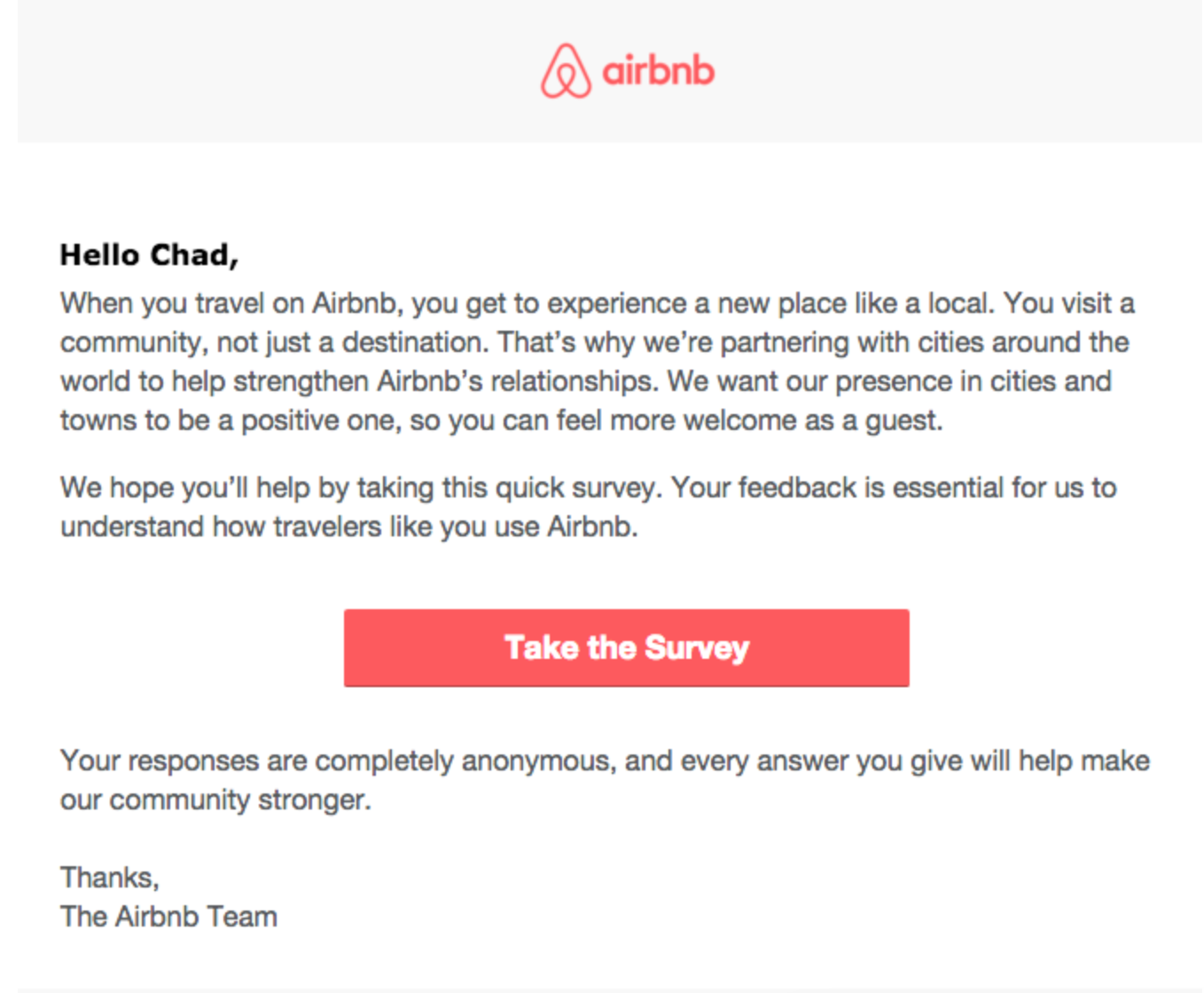
When should you ask customer feedback questions?
Asking customer feedback questions is an excellent way to understand your customers' needs and what they like about your product or service. But, if the company is already established, asking for feedback can take up a lot of time and resources that could be used elsewhere in the business, such as in marketing or production.
It is essential to ask customer feedback questions. When starting out, you should ask these questions as often as possible. This will help you understand your customers and what they want. Product managers use various ways to collect customer feedback, such as surveys, user interviews, polls, customer feedback portals, focus groups, online communities, and social media channels.
Knowing when to ask for customer feedback is vital to improving customer experience. The answer depends on what you are trying to achieve with your product or service.
- When you are about to launch a new product or service.
- After an event or campaign has been completed.
- When you are trying to improve your current products or services
- If you want to improve your customer service.
- To increase conversion rates, asking for real-time feedback after the purchase is best.
- If you want loyal customers, asking for feedback after a few months of use is best.
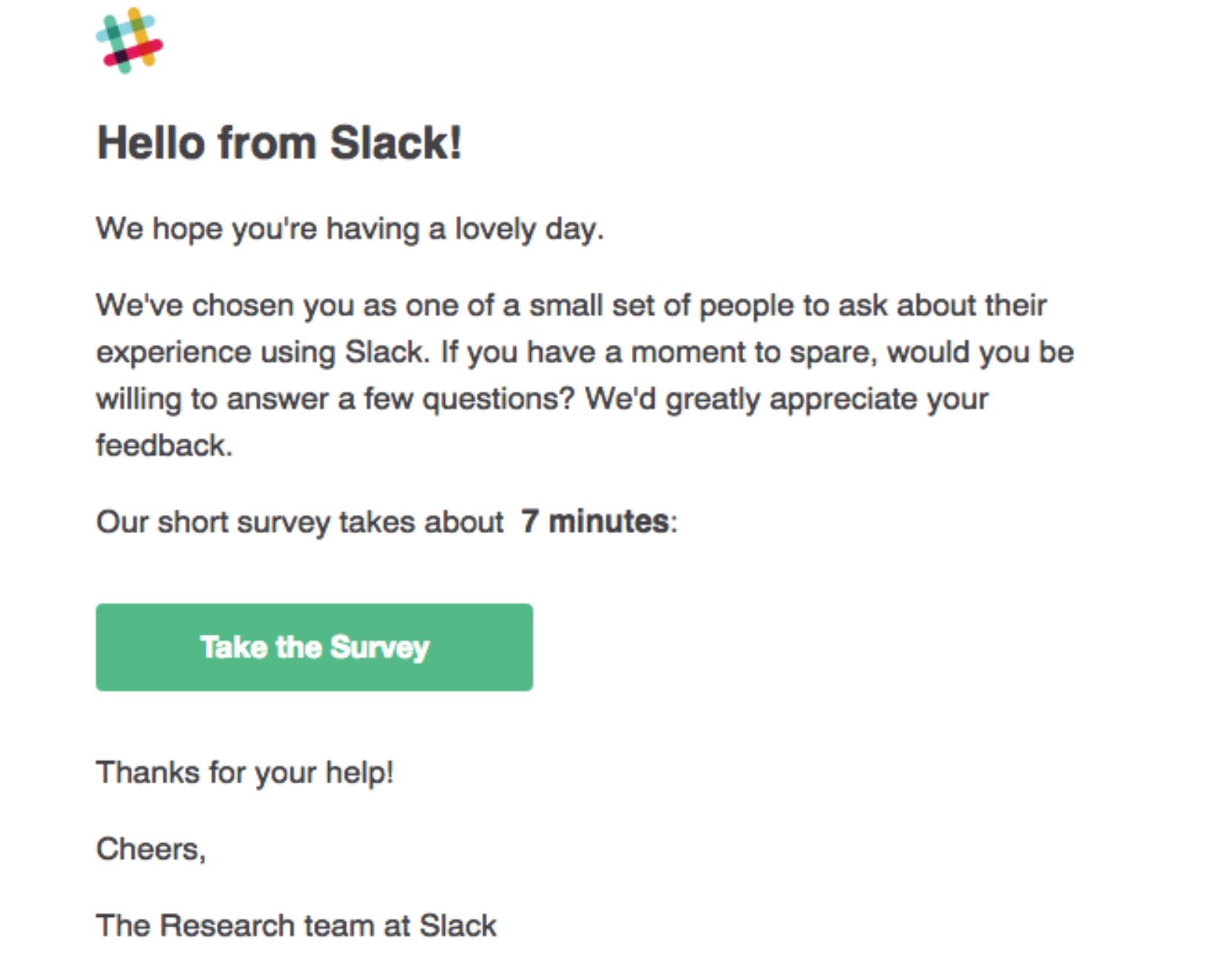
The 11 Most Important Product Feedback Survey Questions & Examples
- How did you hear about our product/service?
- What motivated you to try our product/service?
- What did you like most about our product/service?
- What did you dislike about our product/service?
- How often do you use our product/service?
- What are the benefits you have experienced from using our product/service?
- Is there any feature that you wish our product/service had?
- How likely will you recommend our product/service to a friend or colleague?
- What would you say to someone considering using our product/service?
- Do you want to tell us anything about your experience using our product/service?
- Can we follow up with you in the future for additional feedback or to share updates about our product/service?
Questions Product Managers Should Ask In Customer Feedback Surveys
To have a thriving customer feedback process, it is vital to ask the right questions. The questions you ask will depend on your company’s goals and what you want to learn from the customer.
Looking for customer feedback questions to create customer satisfaction feedback surveys? Look no further. We have compiled a list of feedback categorized into the different goals you can achieve.
Customer feedback questions to understand your customers and inform market research
You may already know who your target audience is. But as your customer base grows, get direct feedback from them to get the customer's voice. Knowing customers also helps you gather psychographic data that you can use to create user personas. These personas help improve user experience and targeted marketing.
1. How would you describe yourself?
Description can mean anything. Help your customers give you better answers by telling them what you expect. E.g., I’m a 24-year bachelor based in the US who works as an Engineer”.
2. What challenge or problem does our product solve for you?
Learn what they expect from your product/service and why they use it.
3. How would you feel if you didn't have our product?
Ask them about their pain points and if your products relieve them of those problems.
4. How well does our product meet your needs?
Could they overcome the problems if they didn’t have your product? Figure out exactly how helpful your product is to the customers.
5. What is your greatest concern about our product?
Is there something that’s stopping them from using your product? You can use their complaints to determine areas where you need to improve.
6. How do you use our product?
Note if and how the features of your product benefit the customers. You may even come across exceptional cases that will give you new insights.
Customer feedback questions to improve your product or service
Ask for unfiltered feedback to see what’s working. What better way to improvise and meet customer needs than constructive criticism? You can use this to create a product-led growth strategy.
7. Which features of our product are not helpful for you?
Ask them which features are working for them. This information will allow you to build better features in the future.
8. What improvements would you add to our product?
Get insights into what your customers need. Any customer, happy or unhappy, will give you suggestions to improve your product. Customer feedback tools like Rapidr allow businesses to collect user feedback and improve their products.
9. What is the main benefit of our product?
Know your customers’ favorite features and make improvements around them.
10. What do you like least about our product?
This feedback will help you change and improve your product.

11. What do you like most about our product?
You can send a survey form with a range of benefits or features along with this question.
12. How often do you use our product/service?
This will help you measure your Customer Health Score (CHS), which lets you know your most active customers. It will also help you understand if customers are churning, and you can take measures to prevent it.
The best way to understand which features are best is to use a feature voting board. You can list down features you’ve planned, and users can upvote the ones they prefer. This will help you prioritize feedback.
Customer feedback questions to improve your customer service experience
Products aren’t the only thing that makes your business run. Feedback from customer-facing teammates, such as customer service and support, is equally important. Sometimes, your behavior and service alone can make or break a loyal customer. Focus on the customer service area with these questions.
13. How responsive was our customer support team to your questions or concerns?
Learn how helpful your team is. The quicker they are, the happier the customer is. Your customer support team can identify common issues that users are having and help product teams make changes accordingly to close the feedback loop.
14. How long did it take to get the desired results from our product?
This question helps you understand the efficiency of the product. Generally, it should take a shorter time to deliver the desired results.
15. On a scale from 0 to 10, how likely are you to recommend (our business) to a friend or colleague?
This question will help you gauge customer loyalty and know how likely they are to suggest your business to other customers. This is also known as Net Promoter Score (NPS), an important customer satisfaction metric.
16. How easy was using our product so far?
Everybody loves simple yet efficient products. With this question, you can simplify any process or feature customers find difficult to use.
17. Is there any way we can improve your experience?
Experience isn’t always limited to product uses. Learn how you can make the overall user experience better for your customers. You can use in-app feedback tool to collect feedback directly from your users while using your product without leaving the app to elevate their experience.
18. How would you rank your satisfaction with our product and why?
Rate this on a scale. It will give you a clearer picture of where your product stands in your customer’s minds. You can then send follow-up questions to them.
19. How did our product impact your life?
Understand how the product impacted the customer. Customers recommend your product to others if it positively impacts them.
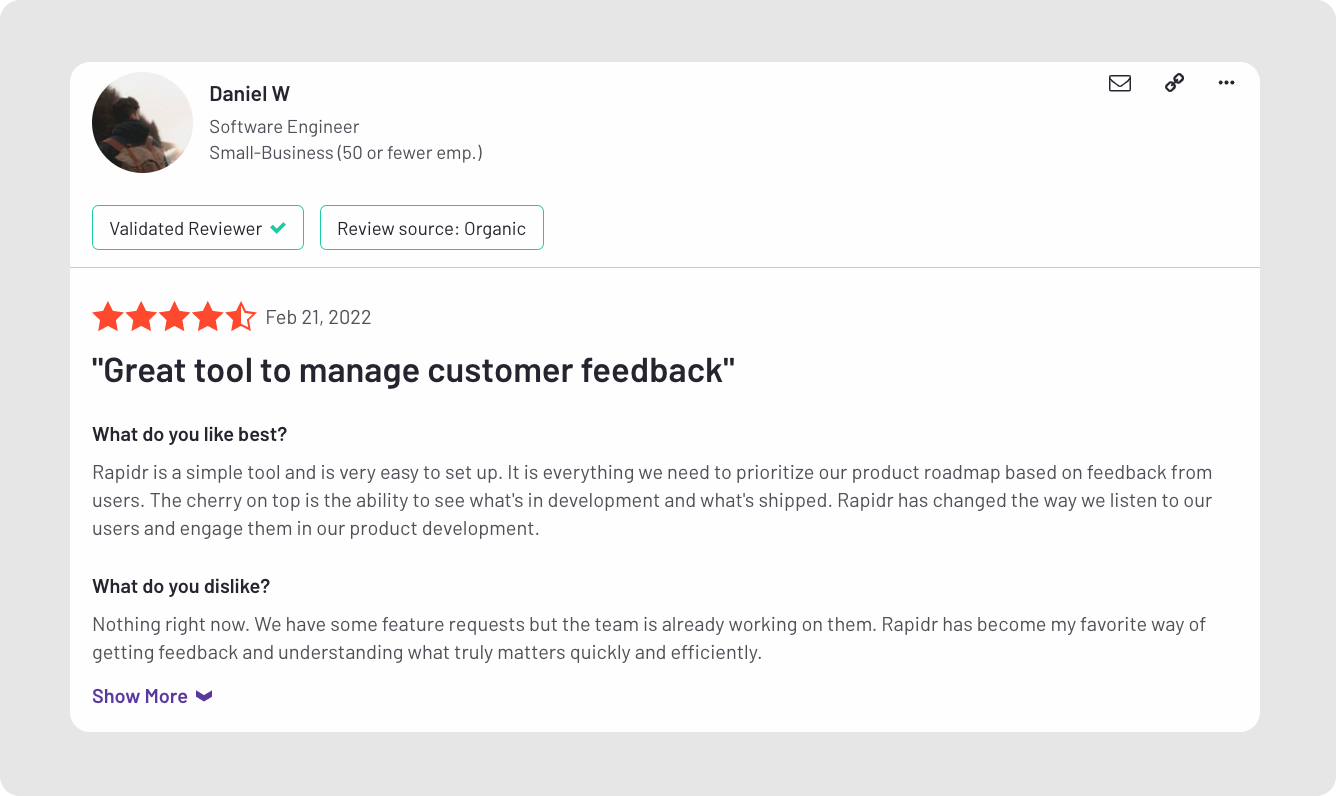
Customer feedback questions for website improvement
Your website acts like your product portfolio. You would want customers to have a smooth and intuitive experience. You can use on-page surveys to ask customers about their website experience and use that to improve your website.
20. How easily can you navigate our website?
This question ensures you know how smooth the user experience is on your website. 1 out of 2 online shoppers abandon pages that take too long to load. So make sure your customers get a good experience on your website.
21. Did you find the information you were looking for on our website?
Ask this to see if your website is missing out on any important or relevant information. You can add further additional information too based on customer feedback.
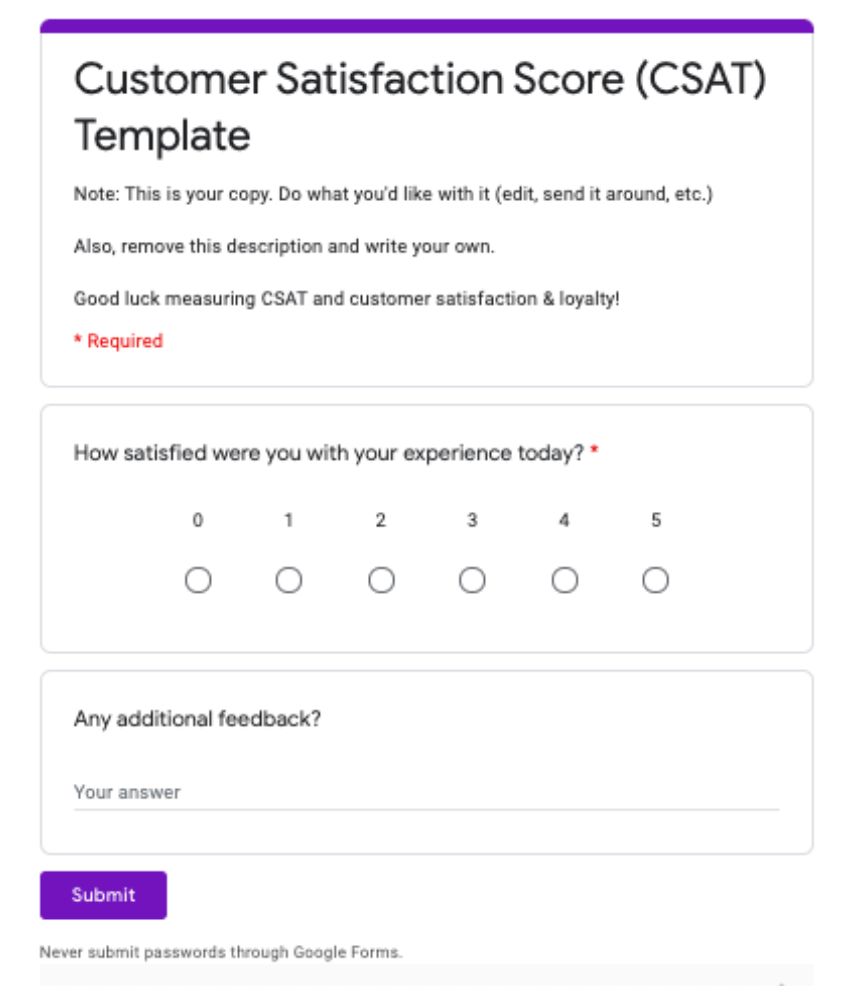
22. What do you think our website is missing?
Your customers are the best people to tell you if your site is missing something. Learn the simple things you can change or tweak on your site. Many product managers use website buttons and feedback widgets with website feedback tools like Rapidr.
Customer feedback questions to improve your marketing efforts
Since marketing requires much time and money, use customer feedback to ensure you’re in the right direction.
23. How did you find out about us?
Knowing where your customers found you can help you advertise your business more strongly on that platform. You know your business is doing well if it’s word of mouth.
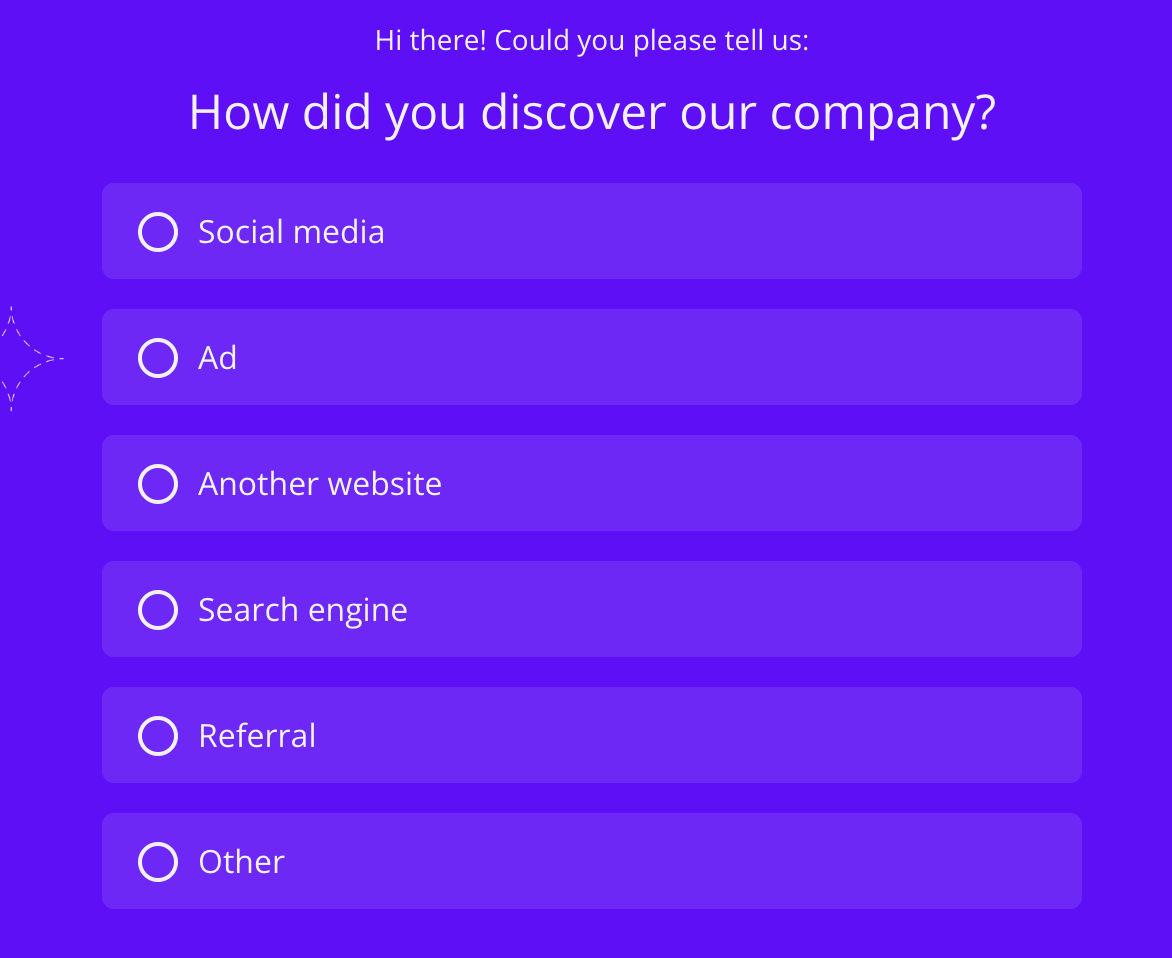
24. Why did you choose to use our product over competitors?
Learn how better you’re performing than your competitors in terms of price, service, and the solutions you offer.
An alarming 72% of consumers report they are likely to switch to a competitive brand after just one bad experience. - CSE Report
25. Did you use a similar product or service before?
Understanding whether the customer has used a competitor’s products or is using them for the first time will add more context to their other answers. Customers with more experience with the product will have different answers than customers using it for the first time.
26. What made you want to try us?
Understand their pain point, which made them subscribe to your product.
27. Why did you leave the previous product/service?
There must be something your customer didn’t like about your competitor. Recognize the “why” and use it to your advantage. Use this information in your marketing campaigns.
28. What convinced you to buy our product?
You can find your USP with this question, too. Replicate and emphasize them for more sales.
Customer feedback questions to understand the purchasing experience
Email a survey to your audience to understand their purchasing experience. Why did or didn’t they buy your product? This survey helps you understand your customer's needs better.
29. Are our products/services priced appropriately?
If customers think your products aren’t worth the money it charges, you must re-evaluate your prices or make the USP more explicit.
30. How easy or difficult was it to complete your subscription?
Learn about the technical challenges your audience may face with your product.
31. How would you describe the buying experience?
A complicated purchasing experience may drive your prospects away. Asking this question will help you retain your future potential customers.
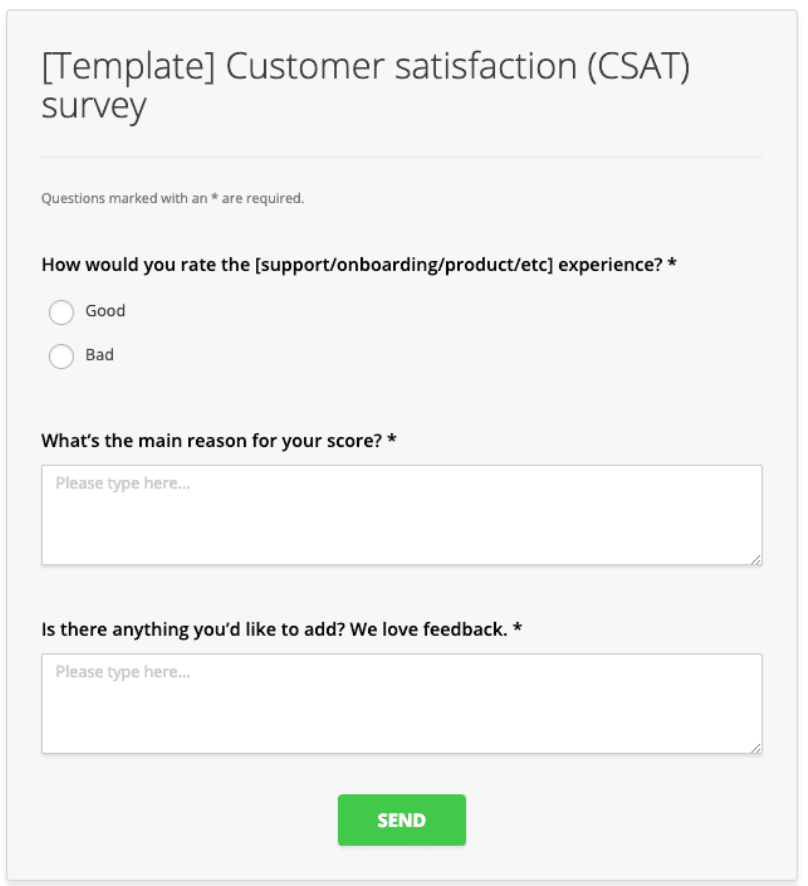
32. Do you feel our product is worth the price?
Send out this question if you’re planning to revamp your pricing strategy.
Customer feedback questions to understand customer churn
Feedback from churned customers is valuable. Ensure you have an exit survey or other methods for off-boarding users.
33. What is the primary reason for canceling your subscription?
Whether it be the price or the quality of the product, know the reason for the cancellation to improvise in those areas.
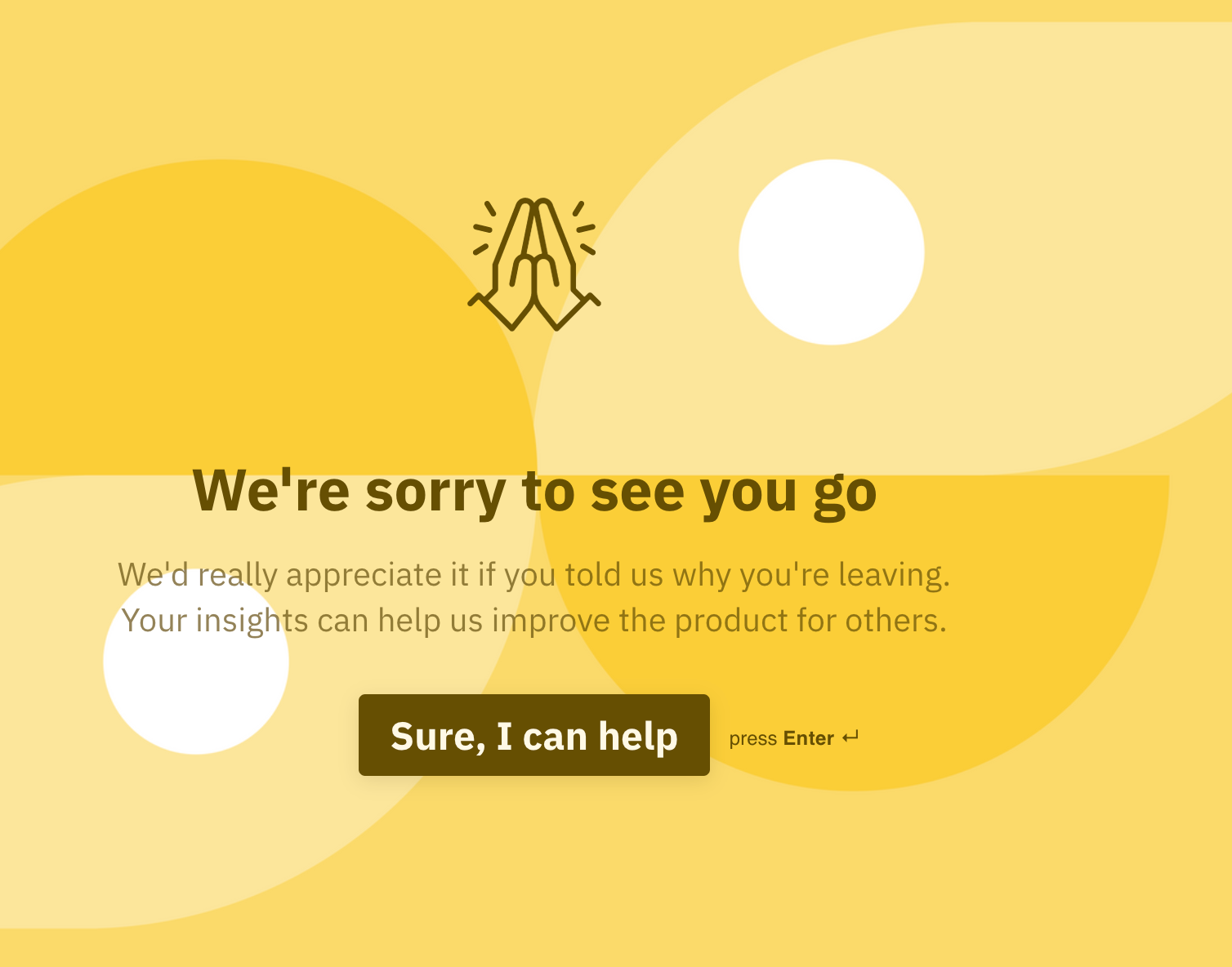
34. Is there anything we can do to stop you from canceling your subscription?
Let customers know you’re open to understanding their needs and helping them.
35. What is preventing you from achieving your goal with our product?
Your product may lack something you’re unaware of. Take the feedback and work on it.
36. Do you have other feedback or concerns you want to tell us?
This is a fundamental question. Learn the additional things you may have missed out on with follow-up questions.
Top 5 Tools to Collect Customer Feedback
1. Rapidr
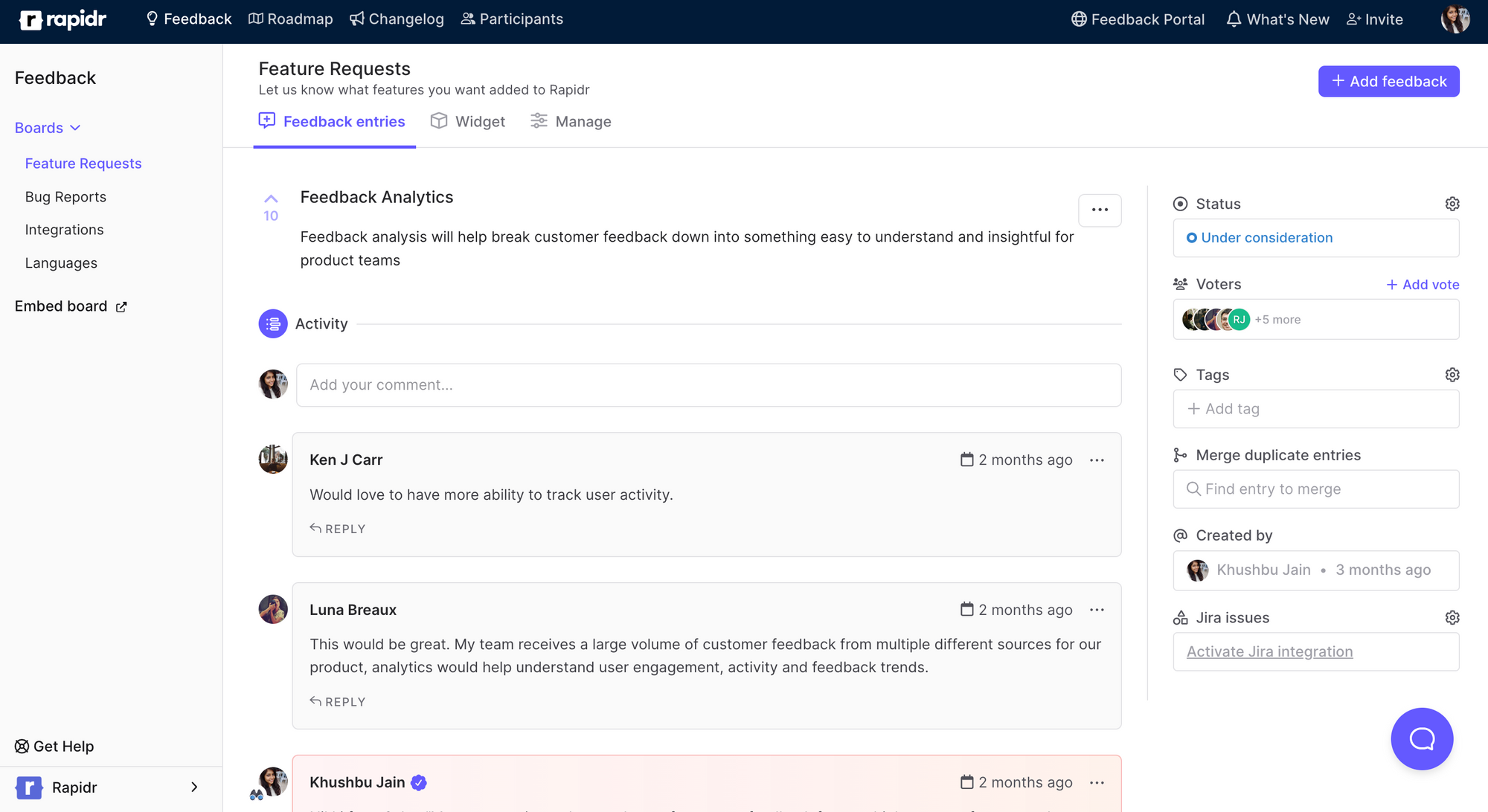
Rapidr is a customer feedback and features a voting tool that helps manage the entire product feedback lifecycle, from capturing product feedback to prioritizing feedback, informing product roadmap, and sharing product updates with changelog.
Rapidr allows you to capture and track all user feedback and organize and analyze them in a centralized location. Then, inform your roadmap with the most impactful feedback, and notify users of what's new with release notes.
Pricing
Rapidr's pricing starts at $49/month, which includes unlimited admins and all the necessary features to get you started in the basic plan.
Use Cases
Product feedback tool, customer feedback management software, feature voting software, feature request tracking system, and In-app feedback.
Features of Rapidr
- Rapidr is an end-to-end product feedback solution, so you don't have to glue multiple apps together. You get feature request collection, roadmapping, and release notes software.
- Rapidr is one of the most cost-effective solutions that offer excellent value for money stacked against the other enterprise options on this list. Rapidr's pricing is based on the value you derive from the software instead of per-seat pricing.
- Rapidr's hosted feedback portal and feedback widgets are lightweight, easy to use, and customizable, fitting perfectly with your existing workflows and brand design.
- Rapidr helps you gather feedback via a feedback portal, feedback widgets, and many integrations with tools you already use, like Hubspot, Zapier, Intercom, and Slack.
2. Hotjar
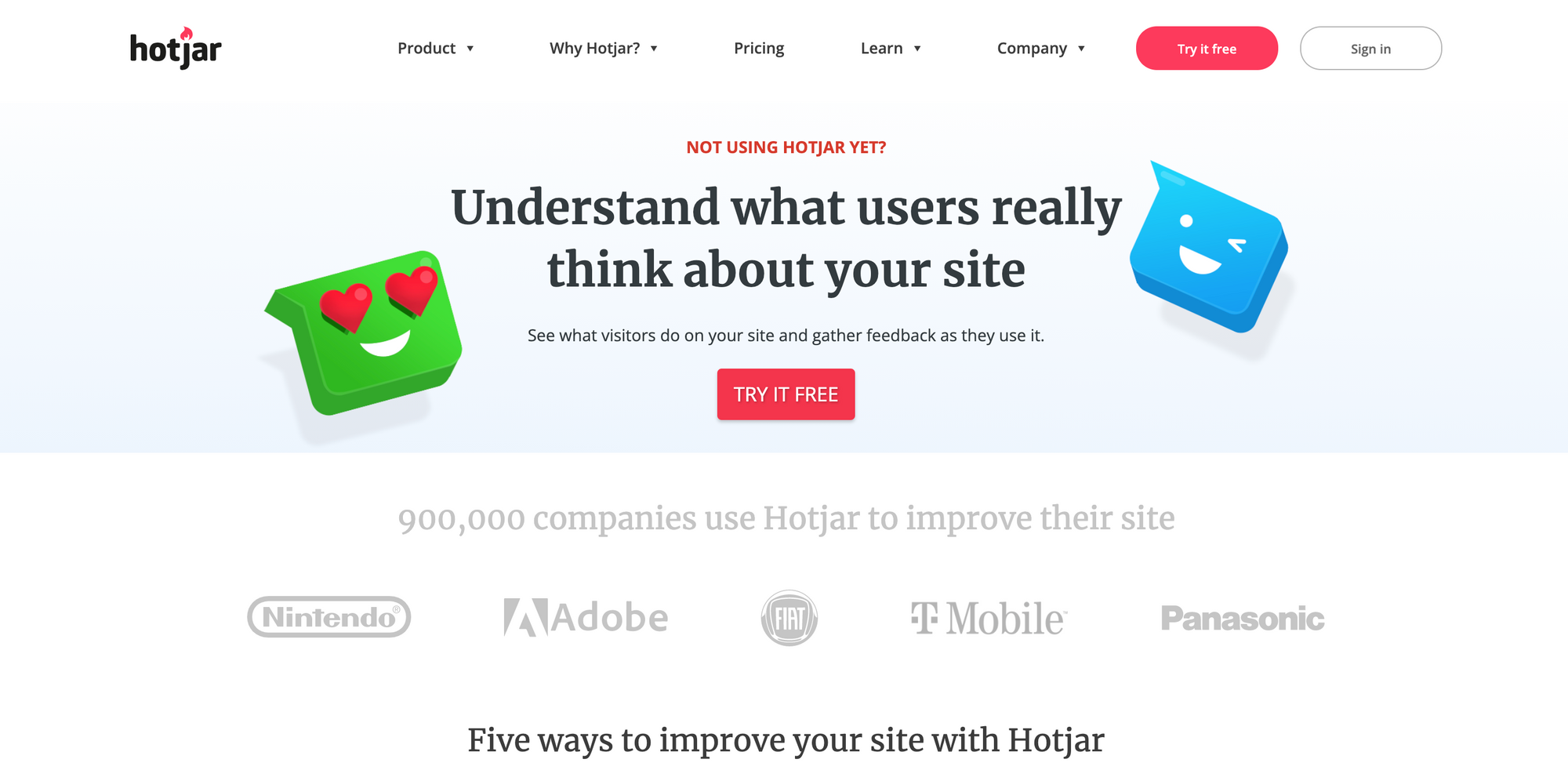
Hotjar is a game-changing analytics tool for page view and user session recordings. It offers analysis and feedback, including Heatmaps, Conversion Funnels, Form Analytics, and Visitor Recording. With these analysis tools, companies can monitor and measure user behavior. In addition, Hotjar provides visual representations of website visitors and their usage behavior.
Pricing: Starts at $39/month
Use cases: Best for user behavior visualizations and tracking.
Features of Hotjar
- Hotjar has a user-friendly user interface. It's lightweight and straightforward to use, doesn't go overboard with complicated functionality, and is plenty robust to provide critical insights.
- Hotjar helps you track customer journeys on your website to improve your customers' on-site experiences and engagements. Hotjar presents its data as visual representations called heatmaps.
- Hotjar is an analytics tool with heatmaps, but feedback is an afterthought. It is more focused on analytics and user behavior rather than being a full feedback solution.
- Hotjar does not have a voting mechanism or a feedback portal.
3. SurveyMonkey
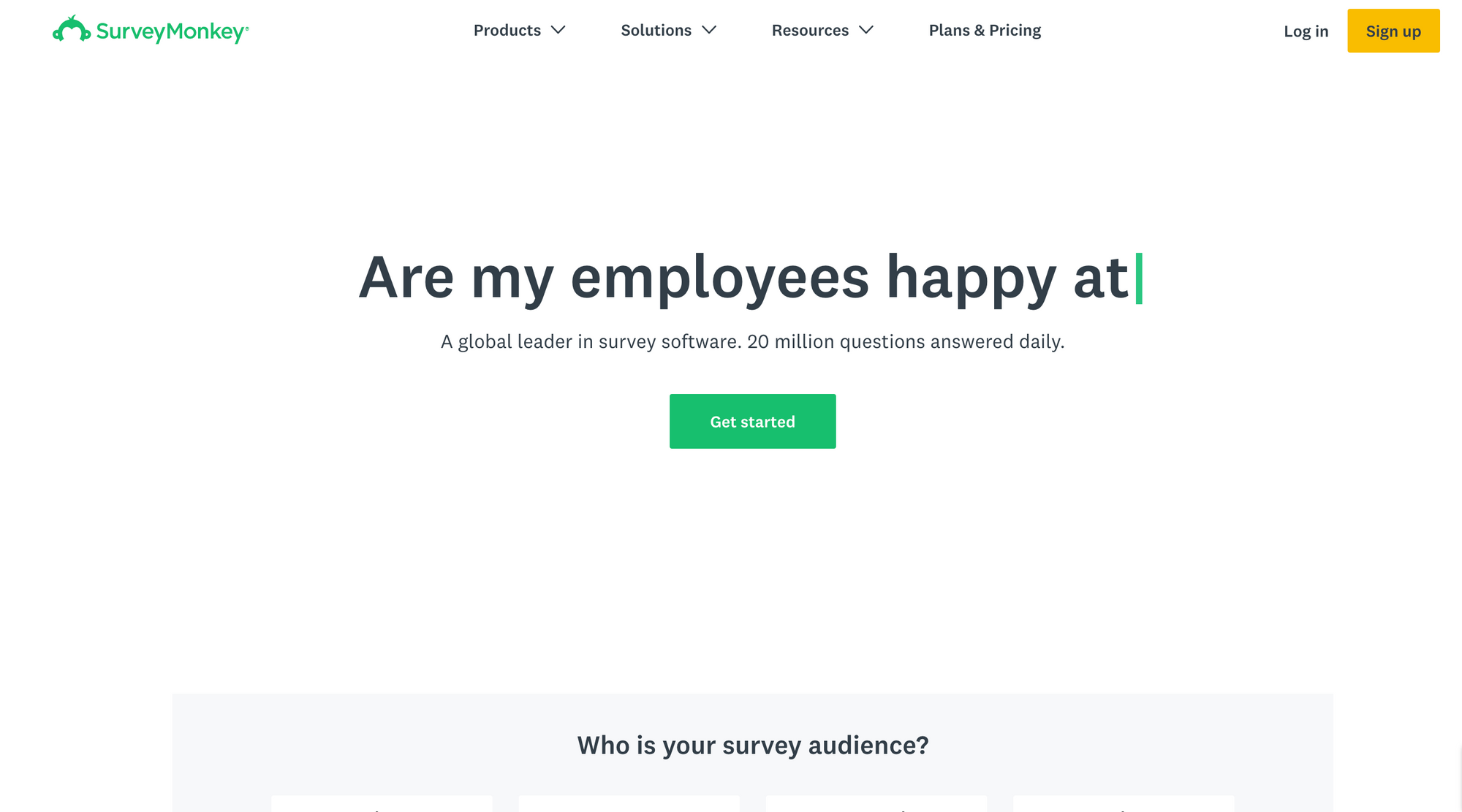
SurveyMonkey all in one survey tool that helps Users run customer satisfaction surveys(CSAT) and NPS to get feedback on products and services and employee engagement surveys to understand employee satisfaction within the company.
Pricing: Starting from $25/month
Use Cases: Best for online surveys and customer insights
Features of SurveyMonkey
- It allows users to send surveys and check on results from a dashboard with specific filtered points showing only desired parts of your survey.
- It helps identify customer loyalty patterns and capture live feedback.
- It's a little pricey compared to the other available options.
4. Typeform
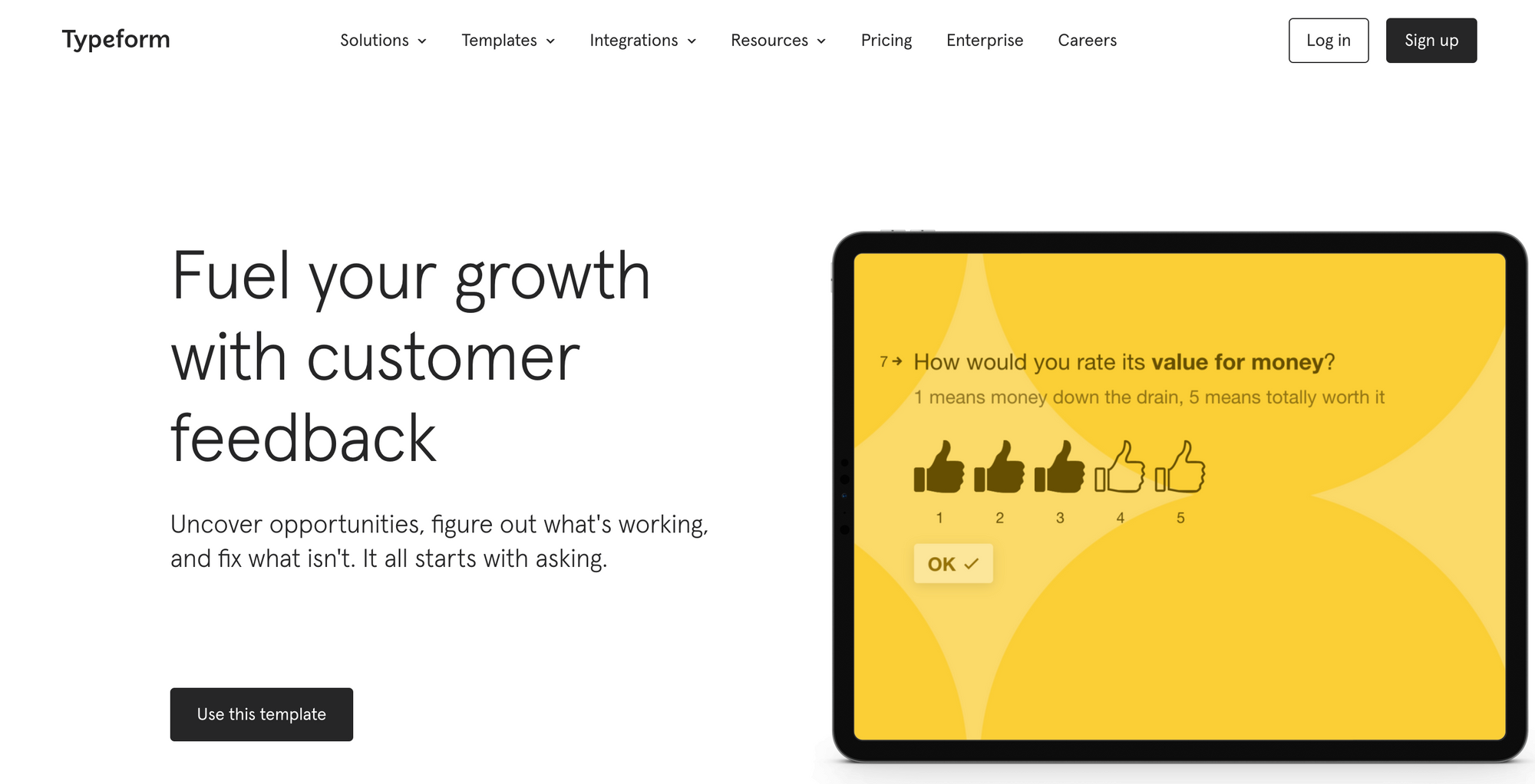
TypeForm is a survey software solution for handling customer feedback management processes that allow the creation of intuitive forms, surveys, and questionnaires and collect different types of feedback. Typeform supports the survey design process with a wide range of templates offered, and the surveys can be built for business-centric purposes, such as lead generation.
Pricing: Starts at $35/month.
Use Cases: Best for user & online surveys
Features of Typeform
- Typeform is handy when embedding additional elements such as videos and images, and the interactive, one-question-at-a-time format of the survey experience has many fans.
- Typeform offers unlimited questions and answers, many themes, a user-friendly interface, and survey analytics, and integrates with various business tools.
- Typeform allows for the aggregation and effective prioritization of feedback at one centralized place like Rapidr.
5. Survicate
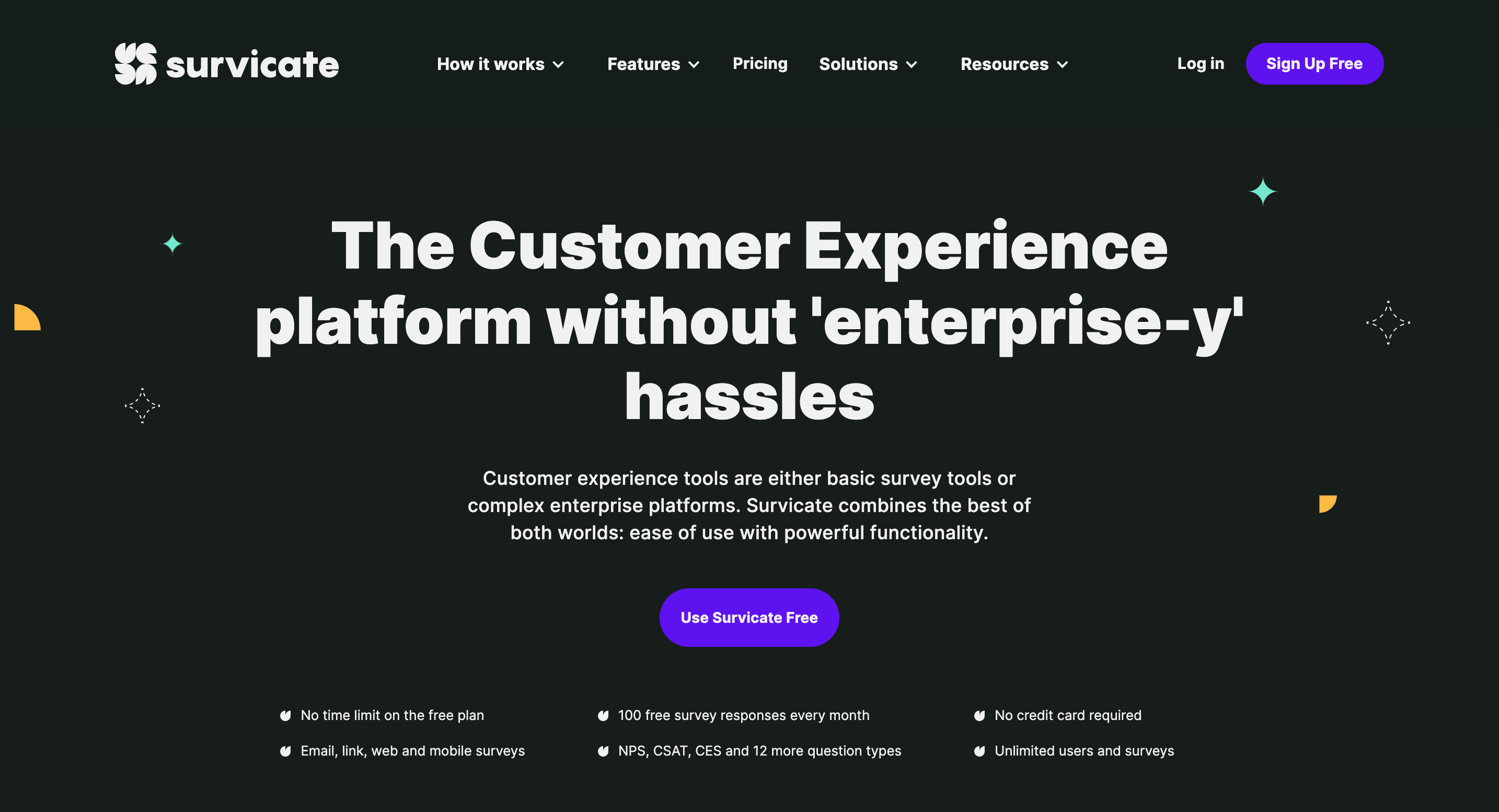
Survicate is a survey and NPS software that helps you capture more customer feedback and deliver a better experience. Send surveys by email, link, or chat. Run targeted surveys on websites to collect customer feedback.
Pricing: Starts at $129 per feature per month
Use Cases: Best for customer experience and NPS surveys.
Features of Survicate
- The UI and interface are easy to use and user-friendly, and the widget design is delightful.
- It is an on-site survey tool that supports many integrations, especially Intercom, and allows customers to easily create survey.
- Being an online survey tool, it doesn't provide advanced functionality to analyze and manage customer feedback or provide a feedback forum and updates about new features to customers.
- Survicate does not offer a free trial to try it out before buying a subscription.
Conclusion
Tailor these survey questions based on your product and prepare feedback forms and surveys. You can test the survey questions with your colleagues before sending them out.
Gathering customer feedback across different channels can get confusing. With Rapidr, you can centralize all feedback and analyze it in one place. This will enable you to build the product experience your customers want.
Get started with Rapidr today to collect user feedback and experience the difference in building better products. Try Rapidr for free for 14 days and keep customer feedback management at your fingertips.
FAQs
1. What is a Product Feedback Survey?
Product Feedback Surveys are used by businesses to understand how their customers feel about the product or service they have purchased and used. It collects customer opinions, insights, and satisfaction levels, which helps companies improve their offerings and customer service.
These surveys can take different forms and contain various questions, depending on what the company wants to learn. For instance, they may ask customers to rate the product's quality, usability, price, or overall satisfaction. Open-ended questions can also be included to gain qualitative insights into what customers like or dislike about the product.
The gathered data can then be analyzed to identify patterns, trends, and areas for improvement. This feedback can play a vital role in product development, pricing strategy, marketing, and more, ultimately contributing to better business performance and higher customer satisfaction.
When conducting a Product Feedback Survey, it's essential to ensure it's concise, easy to understand, and respectful of the respondent's time. Additionally, businesses should follow ethical guidelines regarding collecting, storing, and using customer data.
2. Best Practices for Product Feedback Surveys?
Here are some tips to ensure your product feedback survey is effective:
- Define Clear Objectives: Before creating your survey, clarify what information you're seeking. Whether it's understanding the product's usability, identifying areas for improvement, gauging customer satisfaction, or any other goal, clear objectives will help you create focused and relevant questions.
- Keep it Short and Simple: Long surveys can lead to respondent fatigue, and people may abandon them midway. Try to make your survey concise and to the point. Ideally, it should not take more than a few minutes to complete.
- Use a Mix of Question Types: While Likert scale questions (e.g., rate from 1 to 5) are prevalent in surveys, consider including open-ended questions to capture qualitative feedback and allow customers to express their thoughts more freely.
- Use Simple Language: Avoid jargon or technical terms your customers might not understand. Keep your language simple and your questions clear to avoid confusion.
- Ask About Specific Features: Instead of only asking about the product, ask about specific features to understand what works and what doesn't. This can give you actionable insights for product improvements.
- Ensure Anonymity and Confidentiality: If possible, assure respondents that their responses will be anonymous and their information will be confidential. This can increase response rates and honesty in reactions.
- Act on the Feedback: Once you collect the feedback, analyze it and use it for improvement. There's no point in collecting feedback if it's not utilized. Additionally, consider communicating back to customers about how their feedback is being used to enhance trust and engagement.
- Test Before Sending: Test your survey on a small group before you send it out to all your customers. This can help identify issues with question clarity, survey length, or technical problems.
3. What are the benefits of Customer and Product Feedback Surveys?
Customer and product feedback surveys offer numerous benefits to businesses. Here are some key advantages:
- Improving Products and Services: Customer feedback can highlight areas of your product or service that need improvement. This can guide your development efforts to ensure they align with your customer's needs and wants.
- Identifying Customer Needs: Surveys can help you understand what your customers value and need, and you can then tailor your offerings accordingly. This can lead to more satisfied customers and increased sales.
- Enhancing Customer Experience: By taking onboard feedback from your customers and acting on it, you can improve the customer experience. This can lead to higher customer satisfaction and loyalty.
- Understanding Customer Behavior: Surveys can provide insights into how customers use your products or services. This can help you market your offerings more effectively and identify opportunities for upselling or cross-selling.
- Increasing Customer Satisfaction: Surveys can help you measure customer satisfaction, a key metric for any business. High levels of customer satisfaction can lead to repeat business and positive word-of-mouth referrals.
- Building Stronger Customer Relationships: When customers see that their feedback is taken seriously and leads to improvements, it can build trust and strengthen your relationship with them.
- Gaining a Competitive Advantage: Understanding your customers' needs and wants better than competitors can give you a competitive edge. By acting on user feedback, companies can differentiate their offerings and stand out in the marketplace.

